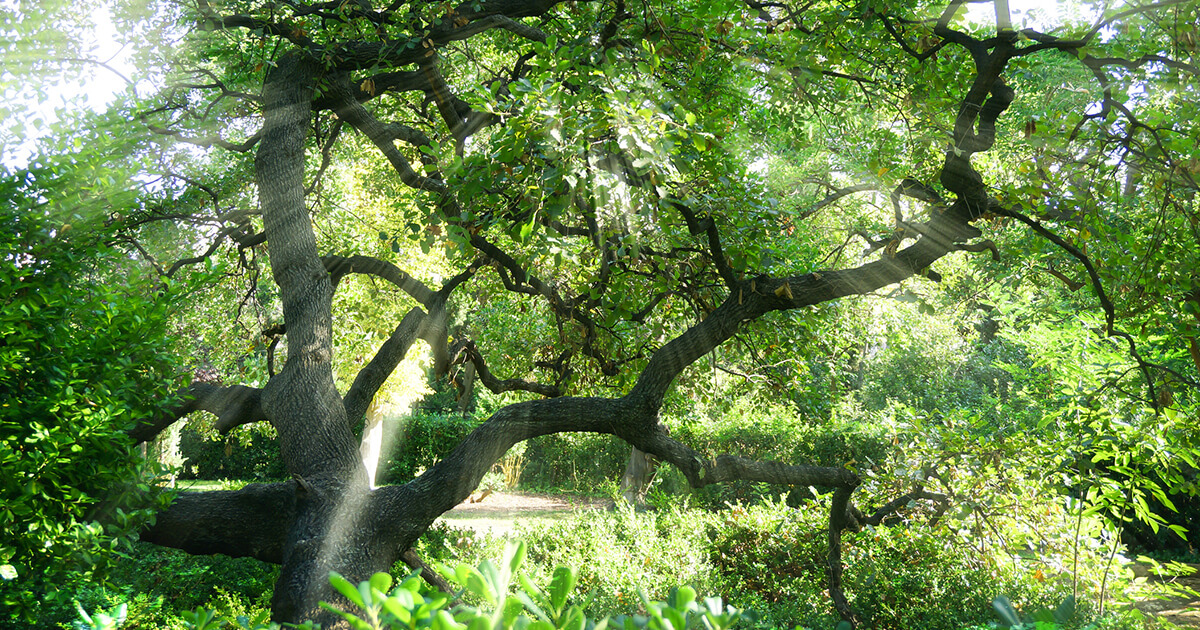The Garden of Eden has fascinated people since the very beginning, and when we say “beginning,” we mean that literally. The Garden is mentioned for the first time in the beginning of Genesis, the very first book of the Bible, and became the home of the very first couple, Adam and Eve.
Here are 7 interesting things about the first garden that you may not have considered before.
1. The Garden of Eden was God’s Garden, planted by God Himself.
At first glance, you might think, “That’s obvious. God created everything and everything belongs to Him.” But that doesn’t make it any less amazing. In fact, the way the Bible describes the origins of the Garden makes it even more fascinating.
Pay attention to two verbs used repeatedly throughout the first chapter of Genesis: God creates the heavens and the earth, makes the sky, creates fish, makes wild animals, and creates mankind. But he doesn’t use either one of the verbs when it comes to the Garden.
When it comes to the Garden, he plants.
“Now the Lord God had planted a garden in the east, in Eden…. The Lord God made all kinds of trees grow out of the ground—trees that were pleasing to the eye and good for food. In the middle of the garden were the tree of life and the tree of the knowledge of good and evil” (Genesis 2:8, 9).
He not only planted this garden, He refers to it in a very personal way. In multiple places, God’s Word refers to the Garden of Eden as “the garden of God” or “the garden of the Lord” (Isaiah 51:3).
Brings entirely different imagery to mind, doesn’t it? We’re not saying God wore a floppy straw hat or had dirt under his nails (and we’re not saying He didn’t). We’re just saying that the picture the Bible paints is of God’s very hands-on involvement in planting a garden He calls His very own.
This Garden was, indeed, a very special place.
2. Talking animals might have been a thing.
“Now the serpent was more crafty than any of the wild animals the Lord God had made. He said to the woman, ‘Did God really say, “You must not eat from any tree in the garden”?’”
The Bible tells us that Eve answered the question and went on to have a brief conversation with the serpent, eventually succumbing to the serpent’s wily ways and eating of the forbidden fruit.
Perhaps the author of Genesis skipped over the part where Eve threw up her hands in surprise and exclaimed, “How are you talking to me? None of the other animals can talk. What’s going on here!?!”
Maybe Eve was so new to the Garden that she had yet to realize none of the other animals could talk.
Or perhaps talking animals were not all that unusual.
It’s certainly something to think about.
3. Whatever tempted Eve did NOT look like a snake as we think of them today.
You’ve undoubtedly seen plenty of illustrations showing Eve being tempted by a slithering snake. Is that an accurate image? In Genesis 3:14 God said to the serpent, “Because you have done this, cursed are you above all livestock and all wild animals! You will crawl on your belly and you will eat dust all the days of your life.”
But if the serpent began life on his belly after Eve ate the forbidden fruit, it makes sense that it didn’t crawl on its belly before the fall. Before the curse, did the serpent walk upright? Did it have legs or even wings? We’ll never know until we get to Heaven but it seems safe to say that the common perception of a legless serpent tempting Eve is wrong.
4. Apples may have been on the list of “approved foods” Adam and Eve were given to eat.
The Bible doesn’t say Eve ate an apple. In fact, God’s Word doesn’t give a physical description of the forbidden fruit at all, except to say that it was edible and attractive (Genesis 2:9, 3:6). In fact, there’s a good chance that apples may have been on the list of “approved foods” God gave Adam and Eve to eat. That’s because, in Genesis 1:29, God tells the new couple, “I give you every seed-bearing plant on the face of the whole earth and every tree that has fruit with seed in it. They will be yours for food.” And apples—at least as we know them today—have seeds.
Obviously, the fruit of the tree of knowledge of good and evil was not on the approved list. Is it possible that it did not have fruit with seeds? We’re speculating here, but it’s possible that the forbidden delicacy was a type of fruit—perhaps seedless?—unlike fruit as we understand it today.
5. Adam started off as a bachelor in the Garden.
We don’t care how popular “The Bachelor” TV franchise is, nothing comes close to the story of the very first bachelor who found love in an exotic setting.
God planted a special Garden and brought Adam there. After Adam had lived alone in the garden for a spell, God created Eve from one of Adam’s ribs and brought her to him.
How long were Adam’s bachelor days in the Garden? The Bible doesn’t say, but we know he was alone long enough to name all the animals and search in vain for a mate.
6. The Garden may never have been meant to be Adam and Eve’s forever home.
The Bible doesn’t directly address this idea, but we do know that Adam and Eve were given an assignment that went far beyond the borders of Eden:
“God blessed them and said to them, ‘Be fruitful and increase in number; fill the earth and subdue it. Rule over the fish in the sea and the birds in the sky and over every living creature that moves on the ground’” (Genesis 1:28).
Of course, everything changed after the fall when Adam and Eve were sent from the Garden, never to return. In fact, to make sure they were protected from eating from the Tree of Life, God “placed on the east side of the Garden of Eden cherubim and a flaming sword flashing back and forth to guard the way to the tree of life” (Genesis 3:24).
The first and tenth chapters of Ezekiel include descriptions of cherubim, and they are fierce creatures indeed, each with four faces (a man, lion, ox, and eagle), four wings, and human hands and form. The soles of their feet are like the sole of a calf’s foot, and they sparkle like burnished bronze (Ezekiel 1:4-14 and 10:1-20).
Between these fierce creatures (and that flashing sword), the garden of God was lost to Adam and Eve—and perhaps to mankind—forever.
7. Where was the Garden? We may never know (at least not in this life).
Many people have tried to pinpoint the location of the Garden. Missionary David Livingstone believed it was located at the mouth of the Nile. Others look to Armenia or the Middle East.
The Bible actually gives pretty good descriptions of landmarks around the Garden of Eden:
“A river watering the garden flowed from Eden; from there it was separated into four headwaters. The name of the first is the Pishon; it winds through the entire land of Havilah, where there is gold. (The gold of that land is good; aromatic resin and onyx are also there.) The name of the second river is the Gihon; it winds through the entire land of Cush. The name of the third river is the Tigris; it runs along the east side of Ashur. And the fourth river is the Euphrates” (Genesis 2:10-14).
Some people say the landmarks named in Genesis mean nothing to us today, since the catastrophic flood in Noah’s day destroyed and rearranged the face of the earth. Other theories say that we can indeed determine something of the location based on the landmarks named in Genesis, as Genesis was written after the flood and the writer would have used landmarks familiar to his post-flood contemporaries.
Bottom line, no one can say for sure where the Garden was located, or if it remains today. And when we consider the whole “sword-bearing cherubim” thing, it’s probably safe to say that, at least for now, that’s the way God wants it.
■
So what do you think? Did you learn anything new? Have you ever wondered why Eve wasn’t surprised to hear the serpent talk? What do you think about the idea that God “planted” the Garden of Eden and calls it His own? Had you ever thought of Adam as the first bachelor to find love in an exotic setting? Share your thoughts in the comments section below.





